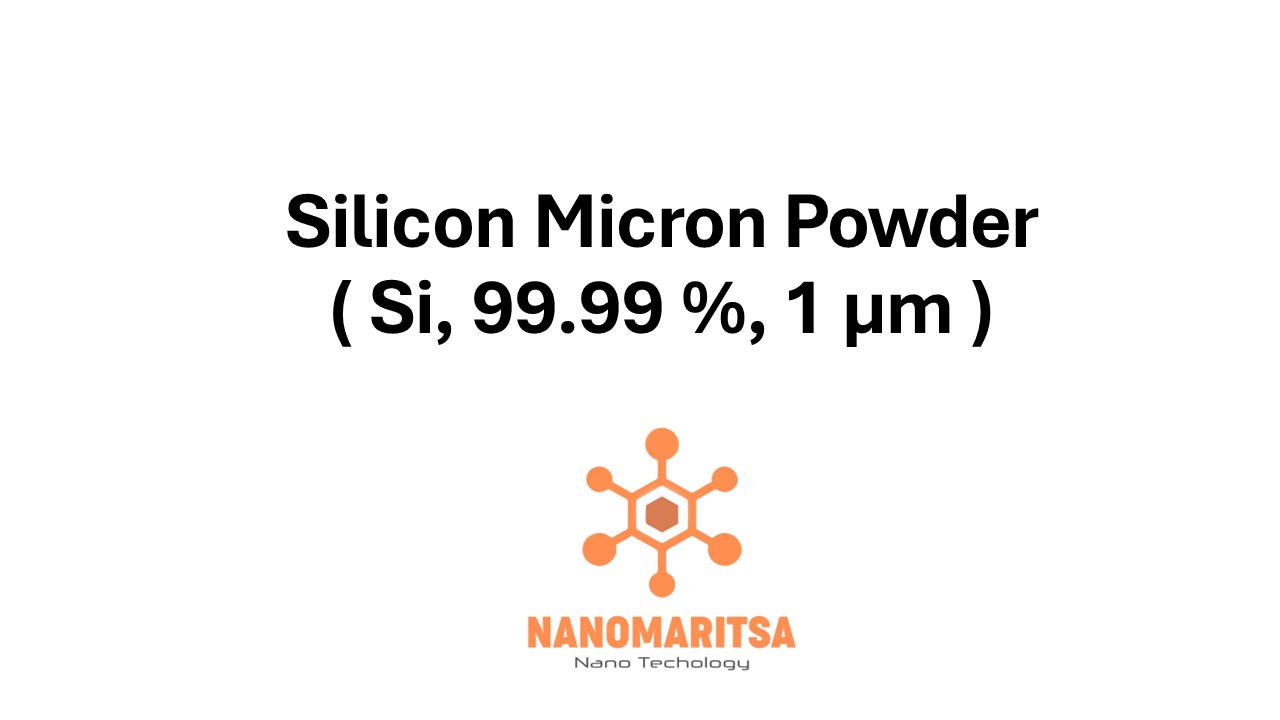Silicon Micron Powder (Si, 99.99%, 1 µm) is a highly refined silicon powder known for its remarkable purity (99.99%) and ultrafine particle size (around 1 micrometer). This fine particle distribution provides a substantial surface area, which is beneficial for processes that depend on high reactivity and uniform dispersion—such as electronics manufacturing, energy storage, semiconductors, and advanced coatings. Silicon is prized for its semiconducting properties, thermal stability, and mechanical strength, making it integral to modern technologies ranging from solar cells to microelectronics.
- Key Properties
- High Purity (99.99%): Minimizing impurities is essential in applications that demand precise electrical or chemical properties, including semiconductor devices and advanced battery technologies.
- Fine Particle Size (1 µm): The ultrafine nature of this powder increases its total surface area, aiding in processes like chemical vapor deposition (CVD), ink formulations for printed electronics, and battery anodes.
- Semiconducting Behavior: Silicon is a cornerstone of the semiconductor industry, used extensively in making integrated circuits, microchips, and various electronic components.
- Thermal Stability: Silicon’s high melting point and good thermal conductivity enable it to perform reliably in high-temperature processes or devices where heat dissipation is critical.
- Mechanical Strength: The robust structure of silicon grants durability and resistance to mechanical stresses, which is essential for applications like MEMS (microelectromechanical systems) and other precision devices.
- Applications
- Semiconductors & Electronics: Fine silicon powders are processed into wafers or used in advanced conductive inks for microelectronics, sensors, and other high-performance electronic components.
- Solar Cells: Solar-grade silicon is employed in photovoltaic (PV) cells to convert sunlight into electricity, with ultrafine powders playing roles in coatings and high-efficiency cell designs.
- Batteries & Energy Storage: Silicon-based anodes are a focal point in developing next-generation lithium-ion batteries, as silicon can potentially store more lithium ions than graphite, leading to higher energy density.
- Coatings & Ceramics: Silicon powder can be added to coatings or ceramic formulations to improve surface hardness, thermal resistance, and mechanical integrity.
- Metallurgical Additions: High-purity silicon powder may be used as an alloying element to enhance properties like strength, corrosion resistance, or conductivity in specific alloys.
- Advantages
- Enhanced Reactivity: A smaller particle size promotes faster chemical reactions, vital in lithium-ion batteries and other high-reaction-rate processes.
- Consistent Dispersion: Fine, uniform particles distribute evenly in slurries, pastes, or composite materials, reducing defects and improving product performance.
- High Electrical Performance: Silicon’s semiconducting nature underpins modern electronics, allowing for the miniaturization and high-speed operation of chips and sensors.
- Thermal Reliability: With a robust temperature tolerance, silicon-based components are suitable for everything from space applications to heavy industrial processes.
- Versatile Manufacturing: Whether for sintering, 3D printing, or thin-film deposition, this silicon powder fits a wide range of fabrication methods due to its purity and ultrafine particle size.
- Recent Trends and Research
- Next-Generation Battery Anodes: Intensive studies aim to optimize silicon’s charge capacity and cycling stability, enabling lighter, longer-lasting lithium-ion batteries for electric vehicles and portable electronics.
- High-Efficiency Solar Cells: Research targets improving solar cell efficiency using advanced crystalline and amorphous silicon structures, sometimes in combination with perovskites or other novel materials.
- Silicon Photonics: Efforts continue to integrate silicon into photonic devices—lasers, optical interconnects—to drive faster data transfer in data centers and networking.
- Flexible Electronics & Sensors: Nanoscale silicon powders and thin-film methods are paving the way for flexible electronic circuits, printable sensors, and wearable technology.
- Sustainable Manufacturing: Innovations in silicon powder production and recycling aim to reduce waste and energy consumption in the semiconductor and energy storage industries.
- Future Prospects
- Advanced Battery Solutions: Silicon-rich anodes could significantly boost electric vehicle range and portable device battery life, provided breakthroughs in preventing volume expansion and degradation are achieved.
- Wider Adoption in Photovoltaics: Continued improvements in silicon-based solar cells, possibly combined with tandem structures (e.g., perovskite-silicon), could further lower the cost-per-watt of solar energy.
- Emerging Semiconductor Technologies: As chips shrink and new architectures develop, ultrafine, high-purity silicon powders will remain essential for cutting-edge semiconductor fabrication processes.
- Micro- and Nanoscale Devices: MEMS devices, sensors, and lab-on-a-chip technologies will benefit from silicon’s mechanical and electrical properties, driving ongoing research and refinement.
- Biocompatible Applications: Investigations into silicon’s potential in biomedical devices—such as implants, drug delivery systems, and biosensors—could spur new markets for high-purity, ultrafine powders.
Boasting extraordinary purity, a 1 µm particle size, and a balanced blend of semiconducting, thermal, and mechanical properties, Silicon Micron Powder (Si, 99.99%, 1 µm) remains a key material for innovations across electronics, energy storage, and advanced manufacturing. Its unique versatility ensures a promising future, as industries worldwide demand ever-more sophisticated, efficient, and reliable solutions.
| Measurement (gr) | 100 grams, 500 grams, 1000 grams |
|---|






